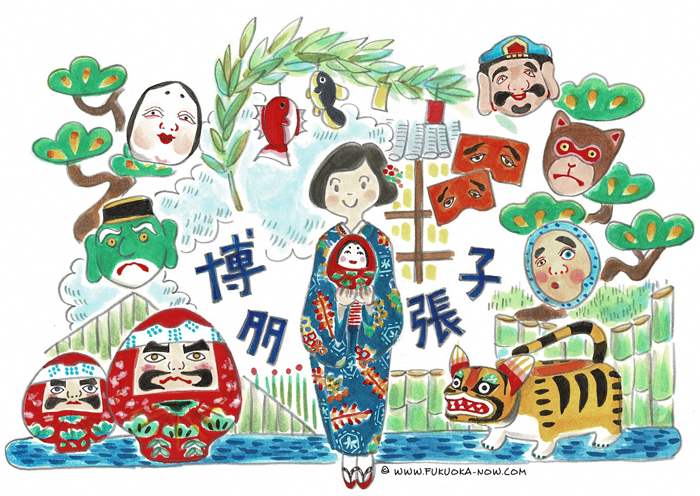Hakata Culture vol.155
Hakata Hariko: Must-have Good Luck Charms of Local Festivals

Hakata Hariko dolls are a local handicraft that dates back to the Edo era. Considered to be good luck charms, popular characters include tigers and daruma. The process of making these dolls has remained virtually unchanged since the Edo era. The artisan covers an earthen or wooden mold with multiple layers of Japanese washi paper or newspaper, which is kept in place with funori (a type of seaweed traditionally used as an adhesive). After each layer is applied, the dolls are left to dry in the sun, and the final step of this painstaking process is to hand-paint the colorful characters.
Hariko dolls were first brought to Hakata in the middle of the Edo era by a local merchant who learned the technique on a trip to Osaka. The hariko technique is said to have originated in China in the second century, and from there, it spread to other parts of Asia and Europe. For example, the traditional masks worn for the Carnival of Venice in Italy are made using the hariko technique.
The technique made its way from China to Japan in the middle of the Heian era, and it was used to make toys and various other items because of the lightweight one could achieve by leaving the inside empty. Hariko dogs have well known good luck charms for safe childbirth and children’s health because dogs have many puppies in a single litter. In Japanese, the phrase “hariko tiger” is used to refer to someone who appears formidable but does not have any power. (the term entered English as “paper tiger” from Chinese.)
Although we don’t see Hakata Hariko very much in our everyday lives anymore, the handicrafts still play crucial roles in local festivals as harbingers of good luck. The sea bream decorations for the Toka Ebisu Festival held every January are made using the hariko technique. Meanwhile, the comical niwaka masks for the Hakata Niwaka dance that is performed at the Dontaku in May are also hariko. What’s more, you can stop by the Hakatamachiya Furusatokan or the Hakata Traditional Craft Center to purchase hariko dolls of the zodiac animal of the new year.
博多の祭に欠かせない縁起物・博多張子
博多の伝統工芸品のひとつである博多張子は、江戸時代から縁起物として作られてきた歴史があり、虎やダルマなど縁起のいい品が今でもたくさん作られています。作り方は江戸時代とほとんど変わっておらず、土で作った型や木の型に、上質な手すきの和紙や新聞紙をフノリで張り重ねて作ります。張り付けるたびに天日で乾かし、最後はひとつひとつ手描きで彩色する手間のかかる民芸品です。
博多張子は江戸時代の中期に、博多の御用商人が上方(大阪)へ行った際に、張子の作り方を学んできたのがルーツとされています。もともと張子の技術は中国で2世紀頃に始まったとされ、その後にアジアやヨーロッパ各地に伝わっていきました。例えばイタリア・ベネチアのカーニバルで使われる仮装用マスクも、伝統的なものは現在でも張子の技法で作られています。
日本には平安時代の中期に中国から伝わったとされ、中が空洞で軽いことから各地の郷土玩具や日用品など、さまざまな用途に利用されました。犬の張子は安産や子どもの健康のお守りとして知られていますが、これは犬が一度に複数の子犬を生むからです。また虎の張子は威勢ばかり良くて中身のともなわないことを指すことわざ「張り子の虎」として定着しています。
日常生活の中で博多張子を見かけることは少なくなりましたが、今でも博多の祭には欠かせない縁起物です。毎年1月の十日恵比寿では飾りの鯛などに使われています。また5月の博多どんたくでは、張子で作った「にわか面」をつけて「博多にわか」が演じられます。毎年の干支の飾り物なども作られており、これらは博多町家ふるさと館や、はかた伝統工芸館などで購入することができます。

